Written by: Ahmed Kabil, PhD Candidate, McNagny Lab (left)
and 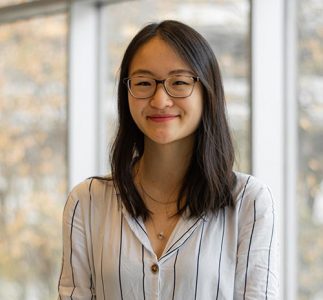
 Loulou Cai, PhD Candidate, Côté Lab (right)
Loulou Cai, PhD Candidate, Côté Lab (right) 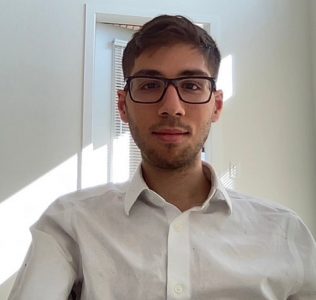
Edited by: Marie-Soleil Smith, PhD Candidate, Côté Lab (centre)
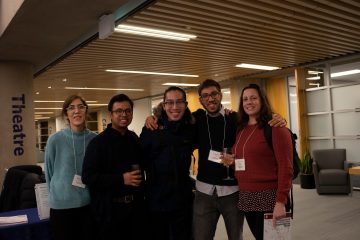
Pictured (left to right): Nooshin Safikhan, Kevin Gonzalez, Steven Jiang, Ahmed Kabil, Marine Theret
The Earl W. Davie Symposium is an annual symposium hosted by the Centre for Blood Research. This symposium brings together researchers, varied healthcare workers, and other professionals for a day of scientific communication, learning, and inspiration. -The 16th annual Earl W Davie symposium was held at UBC Robson Square in a hybrid format, with local and international attendees in-person and over zoom.
Ahmed Kabil quote: “The Centre for blood research is one of the most diverse programs at UBC, representing a slew of viewpoints and that has enriched my experience and sparked amazing ideas that are out of the box”
An Exciting day of Research:
[Ahmed] One of my favourite speakers of the day was Dr. Benjamin Lai, who described a case of a 63-year-old man in his clinic with recurrent small-vessel thrombosis. This thrombosis was associated with antiphospholipid syndrome (APS) auto-reactive antibodies. Most treatment options involve anti-thrombotics, but they do not seem to work well, hence the introduction of other options such as immunosuppressives.
Clinical and mouse data demonstrated that NETosis, extrusion of DNA upon neutrophil death, is highly upregulated in thrombotic APS. This dysregulation provides a perfect scaffold, bringing various protein factors and cells together to propagate and clot. In addition, the activation of the complement pathway appears to be a part of APS driven thrombosis given the decrease in thrombocytes in mice deficient in complement proteins. This opens the door to therapeutic options such as Eculizumab, a complement inhibitor, but its response in patients with catastrophic APS is inconsistent, with 55% of patients non-responsive. Therefore, there is a missing piece to the puzzle.
B cells are known producers of APS antibodies and have been targeted using rituximab (CD20 inhibition), but patient outcomes remain quite variable. Remarkably, despite the depletion of B cells, APS antibody levels remained present, even 52 weeks post-treatment. Ultimately, patients with APS have an immune system that is skewed towards an increased proportion of CD19+CD20- plasma cells, and depletion of these plasma cells is key in decreasing APS antibody expression levels. This indicates that the wrong type of B cell may have been targeted and we should instead look at targeting the CD19+CD20- plasma cells using options such Bortezomib and Daratumumab in the exciting future of APS treatment.
[Loulou] The CBR is a highly multidisciplinary research institute. Dr. Kelly McNagny’s lab is a great example of the breadth of research that CBR members participate in. One project that the lab is interested in is investigating the role of PODXL in tumor progression, and the potential therapeutic potential of two antibodies against different PODXL epitopes.
PODXL is a general adhesion blocker and helps regulate the architecture of the cell surface. Cancers that express PODXL are associated with poor prognosis and high mortality. To investigate The role of PODXL in tumor progression and metastasis was investigated using CRISPR, and it was found that the knockout of PODXL resulted in crippled tumor growth in two different cancer cell lines. PODO83 was the first antibody discussed that exhibits therapeutic potential. Prophylactic therapy with PODO83 was shown to block tumor growth in immunodeficient mice. PODO83 also slows the growth of already established tumors and blocks metastasis in the same mice models. The lab is currently developing humanized mouse models to test for toxicity.
The second antibody,PODO447, specifically binds the tumor-specific PODXL and shows great promise for attacking “cold” tumors (tumors with few immune infiltrates). PODO447 was shown to effectively eliminate tumors in vivo, with higher effectiveness in mice who are not completely immunodeficient. This indicates that treatment with PODO443 works better when residual tumor cells can be killed by the endogenous immune system. This research is an exciting step forward in cancer therapeutics.
The Exemplary Trainees
From oral talks to poster presentations, trainees were prominently featured in this year’s Earl W. Davie Symposium. Six students presented oral talks on innovative topics such as leveraging lipid nanoparticle technology to improve platelet function, modifying clotting factors, and investigating how actin binding proteins regulate platelet cell contraction. The event also showcased 15 posters with a wide breadth of topics ranging from optimizing parameters for blood and platelet storage, improvements to clinical trial implementation, T-cell immunology, to insulin-triggered signaling. Colton Strong, PhD Candidate from the Devine & Kastrup Labs won the People’s Choice Award for best oral presentation, and Henry West, MSc student from the Pryzdial lab was award the best poster award (pictured below).
The Centre for Blood Research would like to thank our event sponsors, without whom the The 16th Annual Earl W. Davie Symposium would not have been possible: the Naiman-Vickars Endowment Fund, Bayer, the Canadian Blood Services, novo nordisk, Stago and GRIFOLS.
Congratulations to the organizers and all the award winners on a fantastic event! See you all next year.
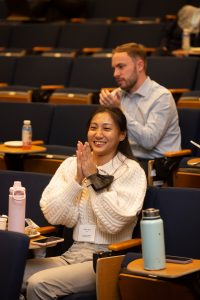
Pictured: Nancy Yang, MSc student, Cote Lab

Pictured (left to right): Taylor da Silva, Cedrik Carter, Colton Strong
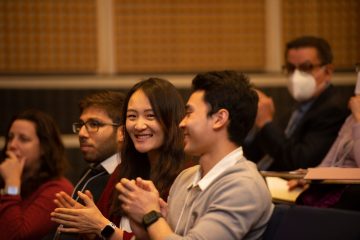
Pictured (left to right): Ahmed Kabil, Loulou Cai, and Felix Hong
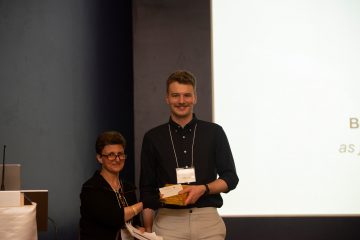
Pictured-second row-left: Dr. Parvin Bolourani (Left), the CBR’s Education Program Manager, presenting Henry West, MSc Student, with a prize for winning the best poster presentation.
Photo by Kitty Liu.


